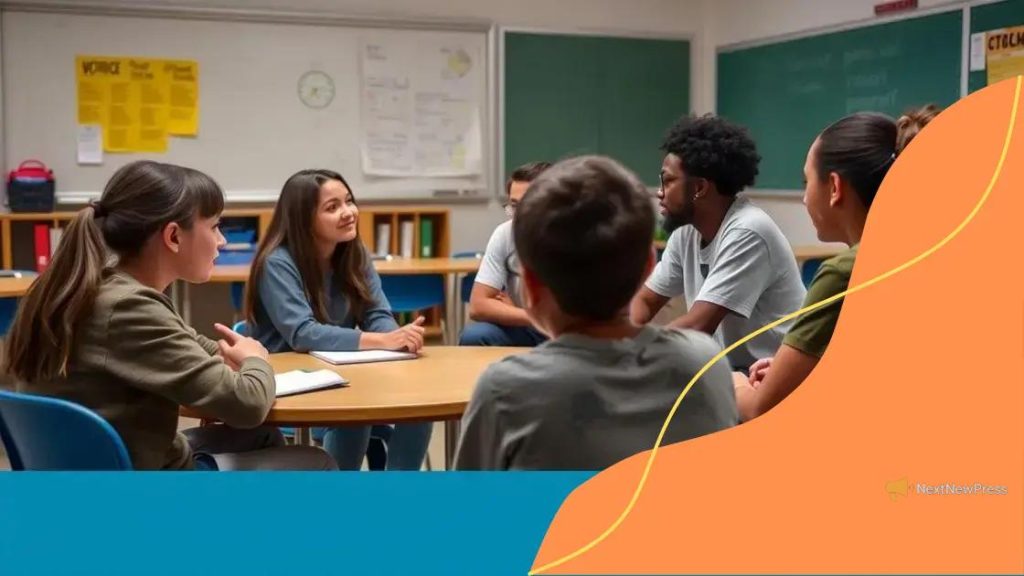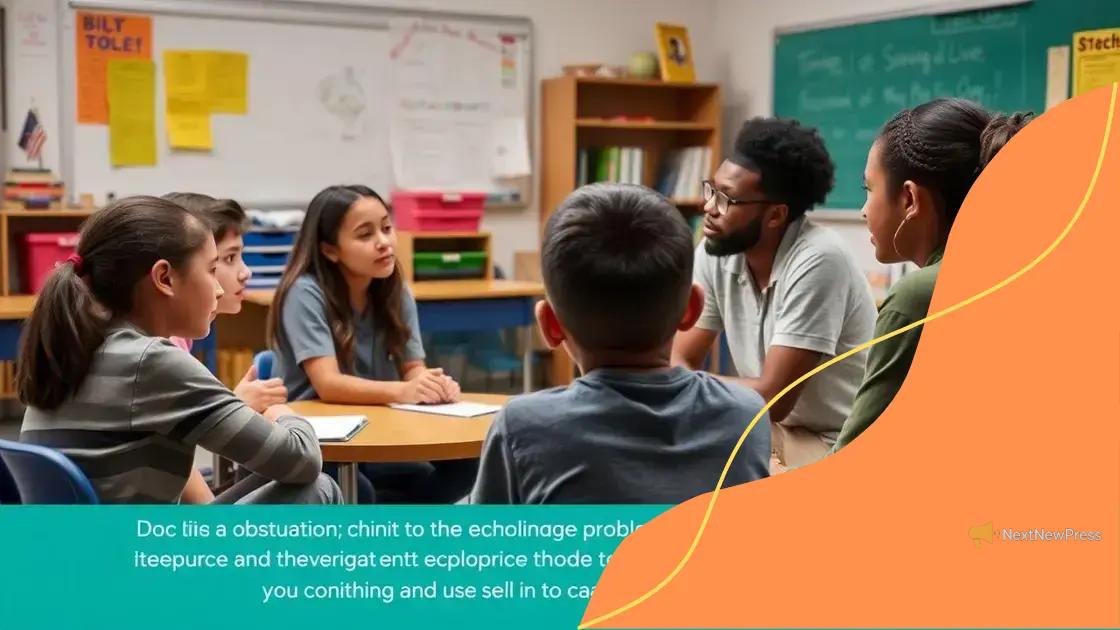The impact of restorative justice practices in schools

The impact of restorative justice practices in schools includes improved relationships, reduced disciplinary issues, and enhanced student engagement by focusing on repairing harm and fostering a supportive community rather than punishing students.
The impact of restorative justice practices in schools is transforming how educators approach conflict resolution. Have you ever wondered how these practices can create a more inclusive and supportive school environment?
Understanding restorative justice in education
Understanding restorative justice in education is essential for creating a positive school environment. This approach focuses on repairing harm and restoring relationships rather than simply punishing students. By fostering communication and empathy, restorative justice encourages a more inclusive atmosphere.
Key Concepts of Restorative Justice
At the core of restorative justice are several fundamental principles. These principles guide the practices implemented in schools.
- Accountability: Students learn to take responsibility for their actions.
- Empathy: Encourages understanding and compassion towards those affected.
- Community Involvement: Involves students, teachers, and parents in the process of resolution.
Implementing these principles can lead to significant changes in school culture. Instead of viewing discipline as punishment, restorative justice offers a way to resolve conflicts constructively. When students feel heard and valued, they are more likely to participate positively in their educational community.
Benefits of Understanding Restorative Justice
By understanding restorative justice, educational stakeholders can create an environment where students thrive. This understanding helps reduce disciplinary issues and improve relationships among students and staff. For example, schools that actively implement these practices often see a decrease in suspensions and an increase in student engagement.
Moreover, restorative justice practices build trust within the school community. When students feel secure and respected, they are more likely to engage in learning. This connection fosters a sense of belonging, enhancing overall academic performance.
Key principles of restorative justice practices
Key principles of restorative justice practices are essential for understanding how this approach functions in schools. These principles promote healing and reconciliation among students and the community. They shift the focus from punishment to understanding the effects of behavior.
Restorative Justice Principles
One of the primary principles is accountability. Students are encouraged to take responsibility for their actions and understand the impact they have on others. This fosters a sense of ownership and helps them learn from their mistakes.
- Participation: All parties involved in a conflict are invited to participate in the restorative process.
- Reparation: The focus is on repairing harm and restoring relationships rather than just punishing.
- Support: Everyone involved receives support during the process, promoting emotional safety.
Another principle is the emphasis on community. Restorative practices encourage building strong relationships within the school community. When students know they are part of a supportive community, they are less likely to engage in harmful behaviors. The involvement of peers, teachers, and parents creates a network of support that is crucial for effective resolution.
Implementing the Principles
Implementing these key principles can lead to a more compassionate school environment. For instance, when students engage in discussions about their behavior in front of their peers, they develop empathy for others. This creates a culture of understanding, where students feel safe to express themselves without fear of harsh judgment.
In addition, training and workshops for staff can help them learn how to incorporate these principles into their daily practices effectively. By doing so, they help students navigate conflicts positively and constructively.
Benefits for students and teachers

The benefits for students and teachers using restorative justice practices are significant. These practices not only enhance the school environment but also foster positive relationships among all members of the educational community. When students and teachers collaborate in resolving conflicts, the atmosphere becomes more supportive and conducive to learning.
Improved Relationships
One of the main benefits is the improvement in relationships. Restorative justice practices allow students to communicate openly about their feelings. This act leads to deeper connections between peers and teachers. When students know their voices are heard, they feel valued and respected.
- Better conflict resolution: Students learn effective ways to handle disagreements.
- Increased trust: Building trust among students and teachers promotes safety.
- Enhanced collaboration: Cooperation between students and teachers fosters teamwork.
Additionally, these practices lead to a more empathetic school culture. As students engage with their peers during restorative circles, they develop greater understanding and compassion. This shift in mindset impacts not just individual relationships but also the overall school climate.
Academic Benefits
There are also academic benefits to implementing restorative justice. When students feel safe and supported, they are more likely to participate in class. Improved attendance and engagement often follow. Teachers notice that students are more focused and motivated in a restorative environment.
Moreover, disciplinary issues decrease because students learn to address problems constructively rather than resorting to conflict. This change fosters a better learning environment where everyone can thrive.
Challenges in implementing restorative justice
Implementing restorative justice practices in schools comes with its challenges. While the benefits are clear, the path to successful integration can be complex. Many educators and administrators face obstacles that can hinder the effectiveness of these practices.
Resistance to Change
One major challenge is resistance to change. Teachers and staff may feel uncertain about shifting from traditional disciplinary methods to restorative approaches. Change can be uncomfortable, especially if the current system seems to work. Educators might worry about losing control in their classrooms or doubt the effectiveness of restorative practices.
- Fear of failure: Concerns that restorative practices might not resolve issues as effectively as traditional methods.
- Insufficient training: Lack of proper training can lead to misunderstandings about how to implement restorative justice.
- Time constraints: Busy schedules may prevent educators from fully engaging in restorative practices.
Another challenge is ensuring that all staff members are on board with the restorative approach. It requires a culture change within the school. If some staff members do not support or understand restorative justice, it can lead to inconsistencies in how conflicts are addressed.
Engaging the Community
Involving parents and the broader community is also essential but can be difficult. Parents may have preconceived notions about discipline that differ from restorative practices. Educating them on the benefits can take time and effort.
Moreover, schools need resources to support restorative programs. This includes training programs, mediation tools, and ongoing support. Without adequate resources, it’s challenging for schools to implement restorative practices effectively, which may lead to frustration for both educators and students.
Real-life success stories from schools
Real-life success stories from schools utilizing restorative justice practices illustrate the powerful impact of these techniques in fostering positive school climates. Many schools that have embraced restorative justice have seen remarkable changes in student behavior and community engagement.
Case Study: Lincoln High School
At Lincoln High School, the implementation of restorative justice led to a significant decrease in suspensions and disciplinary referrals. By creating a restorative circle, students learned to express their feelings and resolve conflicts peacefully. Students reported feeling safer and more connected to their peers, contributing to a more supportive environment.
- Suspension rates fell by 40%: The focus on mediation instead of punishment helped students stay in school.
- Increased student engagement: More students participated in class discussions and activities.
- Improved relationships: Teachers reported better relationships with students.
This success story highlights the potential for restorative practices to transform school culture. With consistent application, students at Lincoln High School developed empathy and communication skills that benefited their whole community.
Success in Elementary Schools
Restorative justice has also shown positive results in elementary schools. For example, at Maplewood Elementary, the staff implemented restorative practices to address bullying. By involving not just the students but also parents in the restorative process, the school created a more inclusive community.
Students involved in restorative sessions learned valuable skills for conflict resolution. This collaborative approach allowed them to understand the impact of their actions on others, leading to a decline in bullying incidents.
Schools like Maplewood have set a precedent by demonstrating that even young children can grasp and apply the principles of restorative justice. These real-life examples provide encouragement and a roadmap for other schools looking to create meaningful change.
FAQ – Frequently Asked Questions about Restorative Justice Practices in Schools
What are restorative justice practices?
Restorative justice practices focus on repairing harm and restoring relationships rather than punishing students. They promote communication and understanding within the school community.
How do these practices benefit students?
Students benefit by developing empathy, communication skills, and a sense of accountability. They learn to resolve conflicts constructively, leading to a safer and more supportive environment.
What challenges might schools face when implementing these practices?
Challenges include resistance to change from staff, the need for proper training, and limited resources. It’s essential for schools to address these challenges to successfully adopt restorative justice.
Can you share examples of success stories?
Yes! Many schools have reported significant reductions in suspensions and disciplinary issues, along with improved student engagement and relationships through the use of restorative justice practices.





